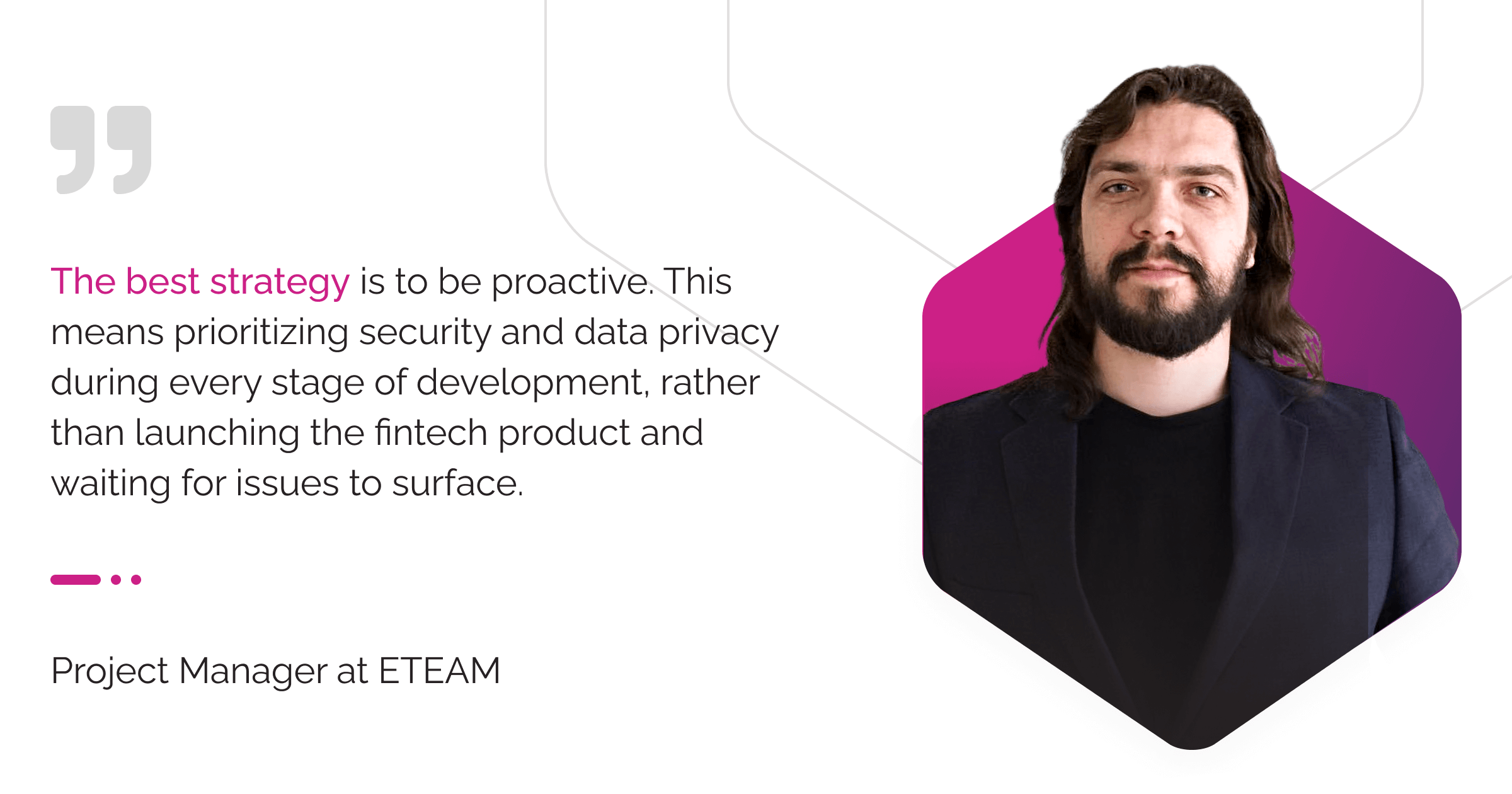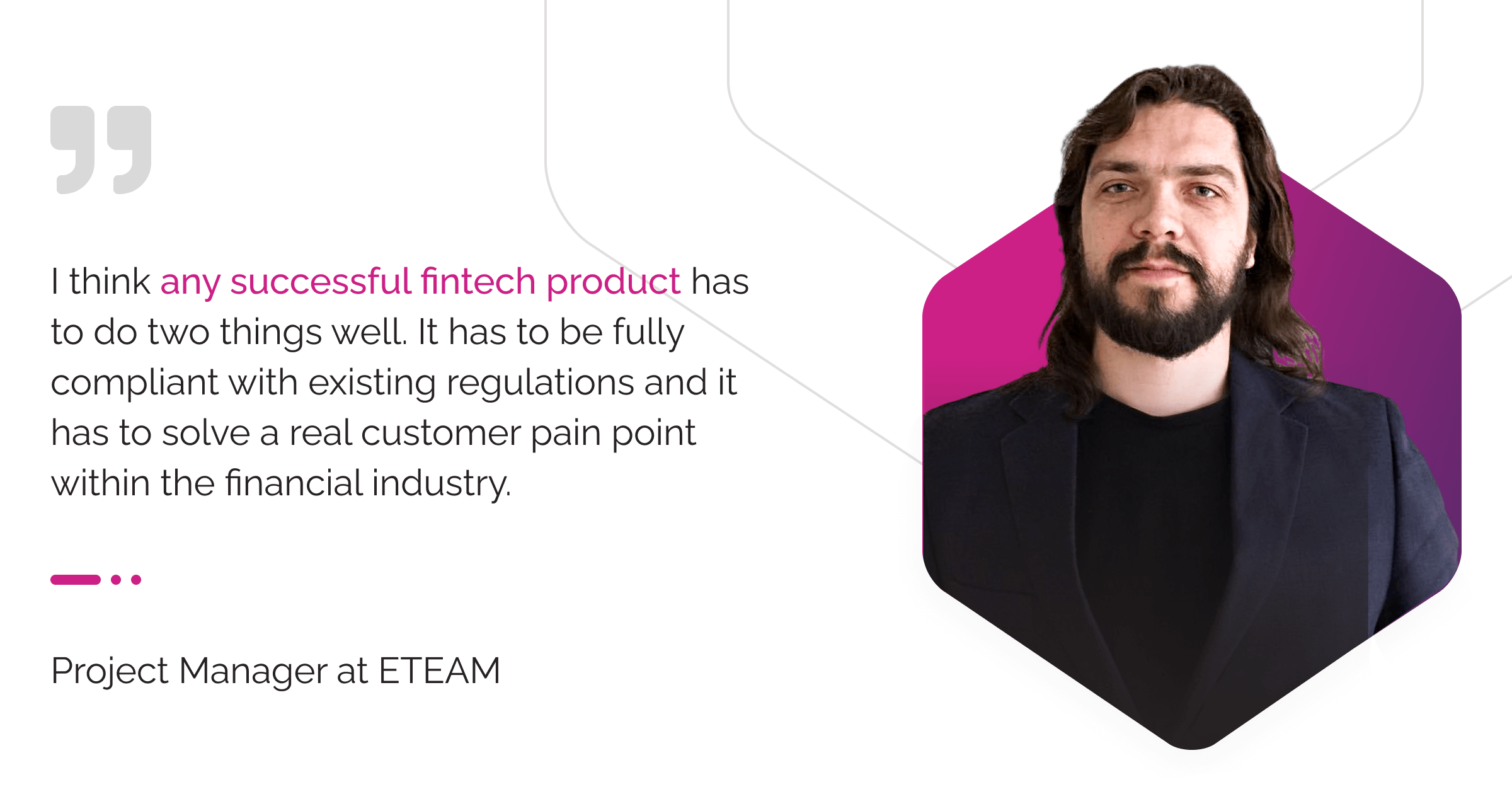Ever wanted to peek behind the scenes of a software development company?
We recently launched ETEAM Talk, a series of interviews where you can meet the experts and innovators driving our agency. Our Head of PMO has already shared some of her best tips on managing software development teams.
Now, we’re sitting down with Oleksandr Radchuk, one of our Project Managers to explore the ins and outs of building cutting-edge fintech products.
Oleksandr is a certified Scrum Master with over 10 years of experience in the tech industry. Before joining ETEAM, he worked as a blockchain lead consultant, overseeing the development of a revolutionary investment exchange powered by blockchain.
Currently, he is putting his years of financial experience to work in managing some of our long-term fintech projects.
Without further ado, let's dive into the interview!
Q1: Previously to ETEAM, you’ve worked as a blockchain advisor and even taught courses at the university level. How did wearing all these hats help you as a Project Manager?
Well, wearing a lot of hats is part of my job :)
As a Project Manager, you work with very diverse teams, from Development and Design to QA and other Project Managers, so you need to be able to navigate all these contexts.
I think my teaching experience contributed a lot to improving my communication skills, which are crucial in this type of cross-functional setting.
Working in blockchain provided me with a good understanding of different fintech industry trends, challenges, and areas of potential. It also made me extremely cautious when it comes to data privacy and security.
Looking back, I think all my previous experiences helped me grow as a Project Manager, especially when it comes to handling projects in a field as fast-paced as fintech.
Q2: What is the ONE advice you would give to aspiring Project Managers entering the fintech sector?
As I previously mentioned, fintech is quite a dynamic field. On the one hand, you have technologies like AI pushing the boundaries of what’s possible, and on the other hand, you have constantly evolving regulations that companies need to comply with.
I would advise any Project Manager looking to break into fintech to stay as up-to-date with the industry as possible. Read whitepapers, industry-focused reports, and case studies.
If you enjoy going to events, attend conferences, or join fintech forums where you can network with other professionals. The bottom line is never stop learning.
Oh yes, and get familiar with the acronyms, haha!
Q3: With the rise of open banking solutions, how do you strike a balance between tight security measures and smooth integration with different financial institutions?
With open banking, companies can access high-quality financial data from a wide range of institutions and use it to create more innovative products. Users have more control over their financial data since they can choose who sees it.
A lot of this data is accessed through APIs, so robust encryption during data transmission and regulatory compliance are key here.
However, in addition to API security and protocols, I think it’s important to create a security-aware culture within your team as a whole. This can take many forms, from working with reliable vendors and conducting security audits to implementing continuous monitoring solutions that can detect threats as they happen and speed up incident response times.
Q4: Security and data privacy are major concerns when it comes to sensitive financial information. What strategies do you use to maintain robust security during development?
The best strategy, from my experience, is to be proactive. This means preparing for risk scenarios ahead of time while also hoping for the best outcome.
It also means prioritizing security and data privacy during every stage of the development process rather than launching the product and waiting for issues to surface.
When it comes to development, we follow strict compliance standards and secure coding practices, including testing libraries we use for vulnerabilities and vetting third-party API providers.
By following a continuous integration approach, we make sure the code gets thoroughly tested as soon as any changes are made.

Q5: It’s no secret that fintech is one of the most competitive and fast-paced markets, with over 500 new fintechs launched every year. How do you manage changing project requirements without compromising project timelines or quality?
This is the million-dollar question, isn’t it?!
How do you get to market fast without shortcuts that compromise quality or take too long because of shifting requirements?
The short answer is by being agile.
The longer answer is through regular monitoring, good communication, and proactive change management.
We always review and approve project requirements with our stakeholders to make sure we are aligned and working toward the same goals. Any change to existing requirements is evaluated in terms of impact before actually making those changes.
-
How big is the change compared to what was initially discussed?
-
How will it affect the schedule?
-
Does this come with certain dependencies that could further delay the process?
Q6: Cryptocurrency trading has been often described as a “Wild West”. Similarly, blockchain and decentralized finance have been criticized for being relatively unregulated compared to traditional financial systems. What’s your opinion on this?
Isn’t this what we always say about new technology? :)
I think everything starts out as a “Wild West” until it becomes part of our daily lives and legal frameworks. Just remember how the Internet itself was perceived back in the early days.
Because of their rapid development, blockchain and DeFi do come with a certain level of volatility and regulatory uncertainty that will level out over time.
But let’s not forget that there’s always a trade-off. While they might not be as regulated as traditional systems, they do offer a higher level of flexibility and inclusivity when it comes to transactions and accessing financial services.
A thoughtful approach that combines innovation with regulatory measures can foster growth while mitigating potential risks in these dynamic markets.
Q7: Can you share an example from your work on how AI and Machine Learning are reshaping fintech products?
We’ve worked on a few projects where we successfully used AI and Machine Learning algorithms to detect anomalies in transaction patterns. This approach has the advantage that it goes beyond a static rule-based system, where you have predefined conditions that must be met.
AI can analyze huge amounts of user data, recognize patterns dynamically, and establish a baseline. Once there is a deviation from the baseline, you get alerted immediately.
I would say AI and Machine Learning ultimately provide a more dynamic and adaptive approach to fraud detection for fintech products.
Q8: Digital payments continue to hold a huge portion of the fintech market. What potential does automation have for payments?
It's really important for fintech products to automate operational workflows wherever possible.
While it might not always be perfect, automation can significantly cut down on human error, especially when it comes to data entry, comparing transactions, and matching bank records or invoices.
Automating payment processes comes with a lot of advantages for businesses, including better cash flow and happier Accounting and Financial teams. Fintech products that cater to this sector usually also include automated reconciliation and reporting for better financial visibility and compliance.
Q9: What is the number one challenge companies face when modernizing their legacy financial systems? How do you help your clients overcome such challenges as a Product Manager?
This again takes us back to automation. In a lot of legacy financial applications, users have to do a big part of the work by hand. Not only this but a lot of operations are usually done outside of the application itself.
Users might store financial information in Excel spreadsheets or exchange files outside the app. Of course, this poses a lot of regulatory and security concerns.
When modernizing financial applications, we take a top-down approach. We look at the existing application to understand its overall architecture, dependencies, and limitations. Then we break the refactoring work into incremental steps so that updates and improvements don’t disrupt the entire workflow.
We also ensure that all data is stored within the application, cleaned, and secured and that users can complete daily tasks with minimum manual effort and without leaving the application.
Q10: The fintech landscape is incredibly diverse - neobanking, wealth management, insurtech, blockchain, regtech, and we could go on. Despite this diversity, is there anything all the successful fintech solutions have in common?
I think any successful fintech product has to do two things well. It has to be fully compliant with existing regulations, and it has to solve a real customer pain point within the financial industry.
For example, a major pain point might be overcomplicated onboarding. This happens a lot in fintech, where users have to provide a lot of information and documentation or undergo multiple verification steps.
However, as a fintech company, you also need to ensure that you are asking your users everything you need to ask them.
So striking the balance between being user-friendly while remaining regulatory compliant is essential.

Q11: How do you see financial products evolving in the years to come? Is there anything new and upcoming fintechs should pay extra attention to?
I’m quite confident that the full potential of blockchain technology is yet to be embraced. There is more to come in this field in the upcoming years.
In fact, I was recently reading an article on how decentralized health record systems can be used in emergency medical care, where first responders need quick access to critical patient information.
Additionally, over the past year, we have witnessed ongoing discoveries in the capabilities of AI technology, with its continuous implementation across different sectors.
Overall, these are the two directions I'd keep an eye on.
If you liked this interview, you can follow Oleksandr on LinkedIn.
Make sure to also follow ETEAM for more behind-the-scenes insights on software development!








